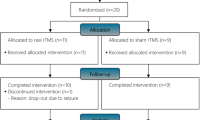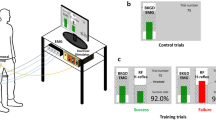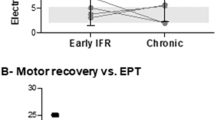Abstract
Study design:
Prospective longitudinal study.
Objectives:
The aim of this study was to examine the effects of transcranial magnetic stimulation (TMS) on the soleus H reflex in patients with spinal cord injury (SCI) before and after locomotion training.
Setting:
Neurorehabilitation hospital in Barcelona, Spain.
Methods:
H reflex was elicited in 29 incomplete patients with SCI at 20, 50 and 80 ms after single vertex TMS, and compared with 13 healthy subjects. Patients were subdivided in two groups according to time since injury (<3 months, 3–12 months), and all received training with electromechanical systems. The H reflex modulation pattern to TMS was reassessed and the results were analyzed as a function of change in the patient clinical score.
Results:
Healthy subjects showed a significant H reflex facilitation at 20 ms (186.1%) and at 80 ms (190.6%) compared with the control H reflex. In patients, the H reflex facilitation at 20 ms was significantly reduced before training (142.5%, P=0.039) compared with healthy subjects. After training, patients with <3 months exhibited an increase in H reflex facilitation at 20 ms (170.7%, P=0.04), a greater gait velocity (P=0.014) and a positive correlation with the walking index for spinal cord injury (WISCI II) scale (P=0.050), compared with those with >3 months.
Conclusions:
TMS-induced H reflex modulation may help in the assessment of changes in the descending control of leg reflexes. Our results suggest that the changes on reflex modulation in patients with SCI occur within the first 3 months after injury.
Similar content being viewed by others
Log in or create a free account to read this content
Gain free access to this article, as well as selected content from this journal and more on nature.com
or
References
Waters RL, Adkins RH, Yakura JS, Sie I . Motor and sensory recovery following incomplete tetraplegia. Arch Phys Med Rehabil 1994; 75: 306–311.
Barbeau H, Wainberg M, Finch L . Description and application of a system for locomotor rehabilitation. Med Biol Eng Compt 1987; 25: 341–344.
Wernig A, Müller S, Nanassy A, Cagol E . Laufband therapy based on ‘rules of spinal locomotion’ is effective in spinal cord injury persons. Eur J Neurosci 1995; 7: 823–829.
Colombo G, Joerg M, Schreider R, Dietz V . Treadmill training of paraplegic patients using a robotic orthosis. J Rehabil Res Dev 2000; 37: 693–700.
Hesse S, Uhlenbrock D . A mechanized gait trainer for restoration of gait. J Rehab Res Dev 2000; 37: 701–708.
Wirz M, Zemon DH, Rupp R, Scheel A, Colombo G, Dietz V et al. Effectiveness of automated locomotor training in patients with chronic incomplete spinal cord injury: a multicenter trial. Arch Phys Med Rehabil 2005; 86: 672–680.
Schieppati M . The Hoffmann reflex: a means of assessing spinal reflex excitability and its descending control in man. Prog Neurobiol 1987; 28: 345–376.
Goulart F, Valls-Solé J, Alvarez R . Posture-related changes of soleus H-reflex excitability. Muscle Nerve 2000; 23: 925–932.
Phadke CP, Wu SS, Thompson FJ, Behrman AL . Comparison of soleus H-reflex modulation after incomplete spinal cord injury in 2 walking environments: treadmill with body weight support and overground. Arch Phys Med Rehabil 2007; 88: 1606–1613.
Misiaszek JE . The H-reflex as a tool in neurophysiology: its limitations and uses in understanding nervous system function. Muscle Nerve 2003; 28: 144–160.
Nielsen J, Petersen N . Evidence favouring different descending pathways to soleus motoneurones activated by magnetic brain stimulation in man. J Physiol 1995; 486.3: 779–788.
Valls-Solé J, Valldeoriola F . Neurophysiological correlate of clinical signs in Parkinson's disease. Clin Neurophysiol 2002; 113: 792–805.
Serranova T, Valls-Solé J, Muñoz E, Genís D, Jech R, Seeman P . Abnormal corticospinal tract modulation of the soleus H reflex in patients with pure spastic paraparesis. Neurosci Lett 2008; 437: 15–19.
Knikou M, Angeli CA, Ferreira CK, Harkema SJ . Soleus H-reflex modulation during body weight support treadmill walking in spinal cord intact and injured subjects. Exp Brain Res 2009; 193: 397–407.
American Spinal Injury Association. International Standards for Neurological Classification of Spinal Cord Injury, revised 2002. American Spinal Injury Association: Chicago, IL, 2002.
Dittuno PL, Dittuno Jr JF . Walking index for spinal cord injury (WISCI II): scale revision. Spinal Cord 2001; 39: 654–656.
Wolfe DL, Hayes KC, Potter PJ, Delaney GA . Conditioning lower limb H-reflexes by transcranial magnetic stimulation of motor cortex reveals preserved inervation in SCI patients. J Neurotrauma 1996; 13: 281–291.
Dimitrijevic MR, Kofler M, McKay WB, Sherwood AM, Van Der Linden C, Lissens MA . Early and late lower limb motor evoked potentials elicited by transcranial magnetic motor cortex stimulation. Electroencephalogr Clin Neurophysiol 1992; 85: 365–373.
Calancie B, Nordin W, Wallin U, Hagbarth K . Motor-unit responses in human wrist flexor and extensor muscles to transcranial cortical stimuli. J Neurophysiol 1987; 58: 1168–1185.
Holmgren H, Kadanza Z, Larsson L . Transcranial cortical stimulation. Late excitability changes in the soleus and tibial anterior motoneurone pools. Electroencephalogr Clin Neurophysiol 1992; 85: 374–381.
Acknowledgements
We thank Raquel López for help with statistical analyses and interpretation, and María Pérez for technical assistance.
Author information
Authors and Affiliations
Corresponding author
Ethics declarations
Competing interests
The authors declare no conflict of interest.
Rights and permissions
About this article
Cite this article
Benito Penalva, J., Opisso, E., Medina, J. et al. H reflex modulation by transcranial magnetic stimulation in spinal cord injury subjects after gait training with electromechanical systems. Spinal Cord 48, 400–406 (2010). https://doi.org/10.1038/sc.2009.151
Received:
Revised:
Accepted:
Published:
Issue date:
DOI: https://doi.org/10.1038/sc.2009.151
Keywords
This article is cited by
-
Effects of postural and voluntary muscle contraction on modulation of the soleus H reflex by transcranial magnetic stimulation
Experimental Brain Research (2015)
-
The Walking Index for Spinal Cord Injury (WISCI/WISCI II): nature, metric properties, use and misuse
Spinal Cord (2013)
-
The effects of transcranial magnetic stimulation on vibratory-induced presynaptic inhibition of the soleus H reflex
Experimental Brain Research (2012)
-
Modulation of the soleus H reflex by electrical subcortical stimuli in humans
Experimental Brain Research (2011)



